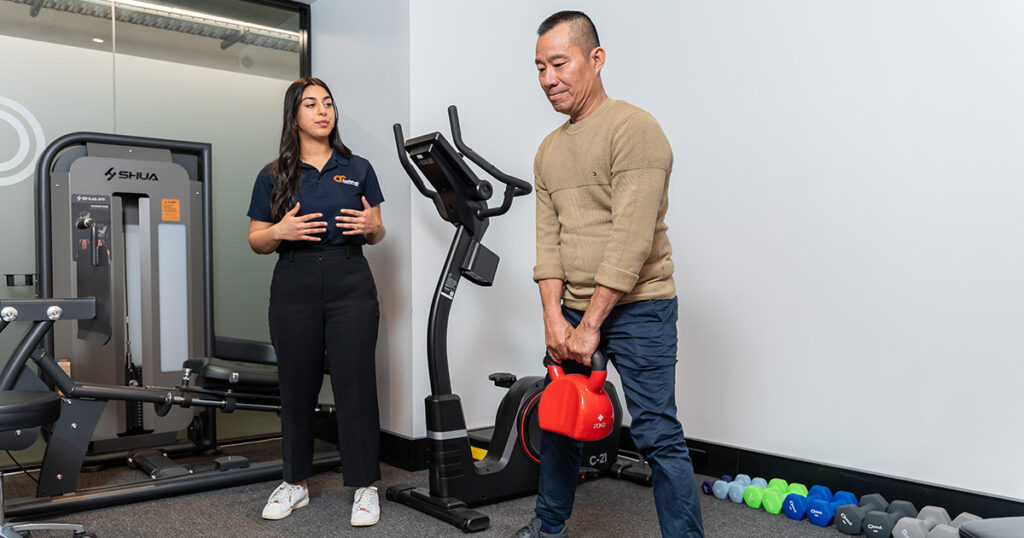• 6 min read
What is a Pre-Employment Functional Assessment?
-
By Suzzy at AusRehab

Before hiring someone for a physically demanding role, it’s important to know they can handle the job safely. A Pre-Employment Functional Assessment (PEFA) helps employers make informed decisions, reduce injury risks, and build a healthier workforce. In this guide, we’ll explore what a PEFA involves, when it’s needed, and why it matters for both employers and employees.
Introduction to PEFA
What is a PEFA?
A Pre-Employment Functional Assessment (PEFA) is a physical evaluation designed to assess whether a job candidate is physically capable of performing the essential duties of a specific role safely and effectively. Unlike a general medical checkup, a PEFA focuses on real-world job requirements such as lifting, carrying, or prolonged standing.
It’s typically conducted by a trained allied health professional, such as an occupational therapists, physiotherapists, and exercise physiologists, and is tailored to the specific demands of the job being offered.
Rather than being a pass/fail test, the PEFA is a tool for matching the right person to the right job, ensuring both safety and productivity from day one.
Why Pre-Employment Assessments Matter
When it comes to hiring, getting the right person for the job requires more than just skills or experience. It also involves assessing physical readiness. PEFAs ensure that a new hire can meet the physical demands of their role without putting themselves or others at risk.
For employers, this means fewer workplace injuries, reduced compensation claims, and a smoother onboarding process. For candidates, it serves as a safeguard, ensuring they aren’t placed in a role that could lead to strain, discomfort, or long-term injury.
In high-risk industries or roles involving manual handling, skipping this step can result in costly mistakes, not just financially, but in terms of human well-being. That’s why PEFAs are increasingly seen as a proactive, responsible part of modern hiring practices.
What to Expect During the PEFA Process
While the idea of a physical assessment may sound intimidating, a PEFA is a supportive and straightforward process. It’s conducted by qualified health professionals who are trained to make the experience comfortable, safe, and role-specific.
Here’s what typically happens during a PEFA:
- Job Overview & Screening
The process begins with a discussion about the physical demands of the role, followed by a basic health screening to identify any pre-existing conditions or limitations. - Functional Task Simulation
You’ll be asked to perform a series of tasks that reflect the physical requirements of the job, such as lifting, carrying, pushing, pulling, and maintaining specific postures. These are controlled and monitored to ensure your safety throughout. - Assessment of Physical Capabilities
Your strength, endurance, flexibility, balance, and overall movement are assessed to determine how well your body aligns with the job’s demands. - Job-Specific Focus
If the job involves manual handling, special attention is given to proper lifting techniques and load capacity. Need help training your team in this area? AusRehab also offers
Manual Handling Training. - Clear Reporting & Feedback
After the assessment, a detailed report is provided to the employer, which includes whether the candidate is fit for duty, partially fit (with recommendations), or not fit based on the job’s physical requirements.
How PEFAs Help Prevent Workplace Injuries
Preventing workplace injuries starts before day one on the job, and PEFAs give employers the insights they need to make informed hiring decisions that protect their people. Many roles come with physical demands that, if not managed properly, can lead to injury. Musculoskeletal issues and overexertion are among the most common workplace injuries across Australia.
Role of Functional Assessments in Injury Prevention
Functional assessments like PEFAs allow employers to identify whether a candidate has the strength, mobility, and endurance needed to safely perform a job. Rather than waiting for an injury to occur, these assessments give insight into physical limitations before a role begins, which means risks can be addressed early.
For example, if a candidate has difficulty lifting or maintaining postures required for a specific role, an employer can explore options such as ergonomic adjustments, targeted training, or reassigning duties. This doesn’t just protect the worker but also protects the team, reduces downtime, and lowers the likelihood of workers’ compensation claims.
The Link Between Fitness Screening and Safer Workplaces
A safe workplace isn’t just about having the right equipment or safety signage, but it’s about making sure every person is physically prepared for the demands of their role. Fitness screenings, like PEFAs, are essential in bridging that gap.
When employees are physically fit for their jobs, they’re less likely to overexert themselves, compensate with poor technique, or suffer from preventable injuries. It also connects closely with broader safety challenges, like fatigue. According to research, fatigue is one of the biggest hidden hazards in the workplace, often reducing focus and increasing the risk of accidents. Functional assessments help flag when someone may not be physically ready, which mitigates these hidden dangers.
Matching Worker Capacity to Job Demands
One of the key principles behind injury prevention and long-term employee wellbeing is simple: the job must fit the worker, not the other way around. Every role has its own physical requirements, and when a person’s capacity doesn’t align with these demands, the risk of injury increases significantly.
Physical Capacity Testing Before Hiring
Before welcoming a new team member on board, it’s essential to understand whether their body can handle the physical requirements of the role, which is a core part of the PEFA process.
These tests evaluate a candidate’s ability to perform essential tasks such as lifting, carrying, pushing, pulling, bending, and standing. But it’s not just about strength, it’s also about coordination, stamina, flexibility, and safety under movement.
Matching a person’s capabilities with the actual demands of the job can reduce the risk of overexertion injuries and avoid putting new hires in harm’s way. It also promotes confidence, both for the employer and the employee, that the role is a good fit from day one.
Physical capacity testing works hand-in-hand with broader assessments like ergonomic reviews, which look at how tasks and workstations can be designed to better support human performance. If you’re considering a full approach to injury prevention, we highly recommend learning more about why your business needs ergonomic assessments.
Functional Capacity Evaluations
A Functional Capacity Evaluation (FCE) is a more detailed assessment that digs deeper into how well a person can perform specific work tasks over a period of time. While similar to physical capacity testing, FCEs are often more comprehensive, measuring not just ability, but also tolerance for sustained or repetitive movement.
An FCE typically includes a series of tasks that reflect real-world job activities, such as lifting to various heights, carrying over distances, or working in awkward postures. These are evaluated with professional guidance to ensure the person is performing them safely and without compensatory movement patterns that might signal a risk.
In addition to baseline measurements, FCEs often consider fatigue levels, postural control, cardiovascular response, and pain behavior, offering a holistic view of a candidate’s physical readiness. They’re especially useful for roles that involve sustained manual handling or work across varied environments.
If you’re looking to prevent workplace injuries, services like ergonomic reviews and manual handling training can help improve safety and reduce risk. For new hires, pre-employment functional assessments offer an additional layer of protection by ensuring candidates are physically suited to the demands of the role before they start.
Why Safe Hiring Begins with the Right Assessment
Hiring isn’t just about filling a role, but about making sure the person you bring in can do the job safely and sustainably. A PEFA gives you that clarity upfront. It reduces guesswork, protects your workforce, and prevents costly injuries down the line. Simply put: the right assessment leads to the right hire.
When Are PEFAs Required?
While not every job requires a PEFA, certain roles carry higher physical demands — and with them, higher risks. In these cases, conducting a functional assessment before hiring is a responsible step toward injury prevention and workplace safety.
Here are the most common situations where a PEFA becomes essential:
High-Risk and Manual Handling Jobs
Roles that involve frequent lifting, carrying, bending, or operating heavy equipment naturally carry a higher risk of injury. Industries like construction, warehousing, transport, manufacturing, and healthcare often rely on manual handling tasks, and a single mismatch between physical ability and job demands can lead to long-term injury, lost time, and compensation claims.
Integrating PEFAs into the hiring process for high-risk roles, employers can proactively reduce injuries, meet duty-of-care obligations, and build a more capable, confident workforce.
Post-Injury Return-to-Work Scenarios
PEFAs aren’t just for new hires. They’re also essential when an employee is returning to work after an injury. Before resuming duties, it’s important to ensure the worker can perform their tasks safely and without risk of re-injury.
In these cases, a functional assessment helps evaluate whether the employee’s recovery is aligned with job demands. It also identifies any necessary modifications or supports that can make their return smoother, such as adjusted duties, ergonomic tools, or gradual reintroduction of physical tasks.
At AusRehab, we believe that recovery doesn’t stop at treatment, and it should continue through meaningful, supported work. Learn more about why recovery at work matters and how it benefits both the individual and the workplace.
Fit-for-Duty Testing and Legal Considerations
In safety-critical roles or regulated industries, fit-for-duty testing isn’t just a best practice, but it can be a legal requirement. These assessments confirm whether a worker is physically capable of performing their duties without risk to themselves or others, particularly after an injury or extended leave.
PEFAs offer objective data to support fair, compliant decisions. These help employers meet their duty of care, align with workplace health and safety legislation, and avoid the legal and ethical consequences of placing someone in an unsafe role. Businesses strengthen their safety culture and demonstrate a genuine commitment to protecting their workforce.
Components of a PEFA
A PEFA is carefully designed to reflect the real physical demands of a job. While each assessment is tailored to the specific role, most PEFAs include a core set of components that help evaluate a person’s strength, mobility, endurance, and tolerance under physical stress.
Here are the key elements commonly assessed during a PEFA:
Lifting, Pushing, and Pulling Tests
These tests are central to most PEFAs, especially for roles involving manual handling. Candidates may be asked to lift objects of varying weights, push or pull loads across different surfaces, or perform tasks at different heights.
The goal isn’t to test maximum strength. It’s to assess whether the person can perform job-specific tasks safely, repeatedly, and without signs of strain. These movements also reveal lifting techniques, posture control, and coordination that form a powerful first line of defense against preventable workplace incidents.
Postural Tolerance and Movement Screening
Not all job risks come from heavy lifting. Sometimes, it’s about how long someone can maintain a posture or perform repetitive movements. This part of the PEFA evaluates how well a candidate tolerates activities like standing, sitting, kneeling, squatting, or reaching for extended periods.
These screenings help detect potential discomfort, fatigue, or biomechanical issues that could lead to strain injuries over time, especially in jobs with repetitive or static tasks. Identifying limitations early can help employers make informed decisions or introduce ergonomic adjustments before problems arise.
Job-Specific Functional Testing
Every role has unique physical requirements, and this part of the PEFA ensures those are accurately assessed. Whether it’s climbing ladders, handling tools, or operating in tight spaces, job-specific testing simulates real tasks a worker would face daily.
This customised approach provides a more accurate picture of job readiness than general physical tests alone. It also empowers employers to make confident hiring decisions based on real-world performance, not assumptions. This level of specificity helps create a safer, more productive workplace from day one, especially in high-risk roles.
Long-Term Workplace Benefits of PEFA
While PEFAs are often viewed as a hiring tool, their value goes far beyond day-one decisions. When used strategically, they become part of a broader injury prevention and workforce sustainability plan.
From improving return-to-work outcomes to reducing claims and building a safer workplace culture, here’s how PEFAs continue delivering results long after onboarding:
Supporting Rehabilitation and Return-to-Work
For employees recovering from an injury, a PEFA plays a vital role in determining whether they’re ready to return, and in what capacity. It ensures that the tasks they resume match their current physical ability, preventing setbacks and supporting a smoother transition back into the workplace.
Pairing this with a structured recovery plan reinforces a culture that values safety and care. Learn more about why recovery at work is so important and how it benefits both workers and businesses.
Reducing Long-Term Injury Risks
PEFAs help catch risks early, before they evolve into chronic injuries or recurring claims. Make sure a worker is physically suited to the job, and employers can avoid repetitive strain, overexertion, and musculoskeletal injuries that often develop over time. This approach lowers absenteeism, boosts morale, and helps build a stronger, healthier workforce, one safe hire at a time.
PEFA as Part of a Safety-Focused Hiring Strategy
Embedding PEFA into the hiring process signals that your business puts safety first, not just compliance. It shows potential candidates, current employees, and stakeholders that you’re committed to building a workplace where health, performance, and long-term well-being are non-negotiable.
More than just a test, PEFA functions as a strategic tool. And it pays off in fewer injuries, better job matches, and a workplace culture built on trust and prevention.
Partner with AusRehab for Safer Hiring
Pre-Employment Functional Assessments go beyond meeting compliance by helping create safer and more productive workplaces. AusRehab’s PEFA services are tailored to match job demands with worker ability and reduce injury risk from day one.
Book a PEFA Assessment
We offer comprehensive assessments across:
- High-risk industries
- Return-to-work pathways
- Manual handling roles
📞 1300 391 947
📧 office@ausrehab.com
Frequently Asked Questions
What does a functional assessment include?
It includes physical tasks like lifting, carrying, pushing, pulling, and posture-based movements, all tailored to the job.
What happens during a PEFA?
A qualified assessor guides the candidate through role-specific physical tasks to evaluate strength, mobility, and tolerance.
Is a PEFA required for all jobs?
Not always, but it’s highly recommended for roles involving manual handling, high risk, or physical strain.
How does PEFA reduce workplace injuries?
It identifies physical limitations early, helping match people to roles they can safely perform, preventing strain or injury.
How long does a PEFA take?
Most assessments take between 1.5 and 3 hours, depending on how physically demanding the job is.
Can you fail a PEFA test?
Not exactly, results indicate whether a candidate is fit, partially fit (with recommendations), or not currently fit for the role.
What types of jobs benefit most from PEFA?
Roles in construction, warehousing, healthcare, transport, and any job requiring physical tasks or manual handling.
Is psychological or behavioural testing part of PEFA?
No, PEFA focuses only on physical capabilities. Other assessments are needed for mental health or behavioural screening.
Don’t forget to share!
Subscribe to stay updated on the latest workplace news.

Resolve your work
place injury today
